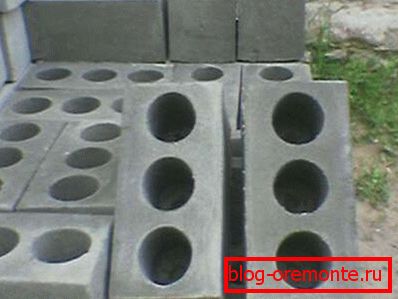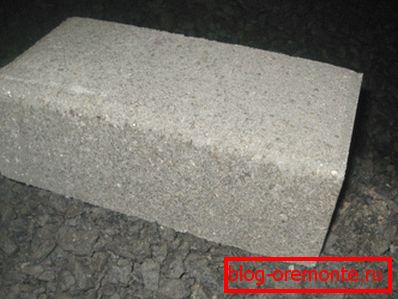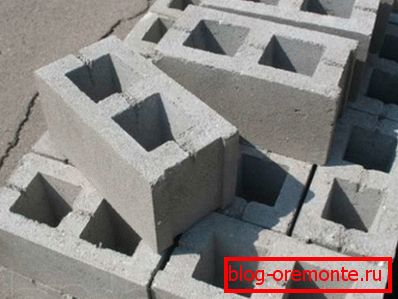Concrete bricks: types. characteristics and applications.
Concrete stone is a building material that is actively used when laying foundations, basements, basement walls. It can also be used as a cladding material for walls, building various kinds of supporting and enclosing structures. Concrete brick is produced according to GOST, which guarantees its high quality.

Why this particular material
There are several main advantages of this building material that immediately answer many questions about the appropriateness of its use.
| Thermal conductivity | Keeps warm and maintains a comfortable level of humidity in the room. |
| Strength | Отличается большей прочностью, чем силикатные и керамические кирпичи, что позволяет спокойно использовать его даже при закладке фундаментов многоэтажных домов. Strength и алмазное бурение отверстий в бетоне доказывает это. |
| Not flammable | It is a fireproof material, and therefore, has high fire-fighting properties. |
| Frost resistance | It is a frost-resistant material, not subject to any deformation at extremely low temperatures. |
| Environmental friendliness | Absolutely environmentally friendly material that does not emit any harmful substances into the environment. It is not radioactive, that is, it does not “fonite”, unlike the same granite. |
| Cost of | Attractive price makes it more than popular material. |
Characteristics and applications
По технологии производства, различают полнотелый и пустотелый кирпичи и у каждого из них есть своя сфера использования (читайте также статью «Бетон W12: характеристики и применение»).

Concrete solid brick is an excellent material for the construction of heavy structures and foundations.
Immediately, we note that it is different:
- increased strength.
- Water resistant.
- Serious indicators of frost resistance.
The last factor is of great importance during construction in regions where lower air temperatures prevail. And the great strength makes it an indispensable material when laying the foundation.
The ability to tolerate low temperatures without deformations and not to succumb to the damaging effects of water, allows it to be used as a material to fill the space between the foundation blocks when building block strip foundations. That is, in fact, it is an alternative to the monolithic termination of such spaces.
Note! The use of solid brick helps significantly reduce construction time.
Hollow
The instruction states that, unlike solid brick, hollow can not be used for laying the foundation, or for multi-storey construction. But it is perfect for the construction of cottages, villas and residential buildings with a height of no more than three floors. Of course, cutting of reinforced concrete with diamond circles is not required for a hollow, but it also has its advantages.

As a material for construction, it can be used for:
- The construction of load-bearing walls in low-rise construction.
- The construction of interior partitions.
- The annexes of low-rise type.
Note! In principle, in multi-storey construction, hollow type is well used, but not as a bearing element. Possessing excellent sound insulation and sound absorption, it remains indispensable in the construction of partitions in apartments and office space.
Facing option
Concrete facing bricks were widely used. Such qualities as durability and visual appeal allow it to be used for finishing the external and internal walls of rooms.

This stone may have an uneven front surface to successfully imitate natural material. The facing brick from concrete with success is applied to dressing practically any surfaces.
And the high quality of performance and the characteristics of the offer itself allow the cladding to maintain its “marketable appearance” for decades. It is also important that in the presence of basic skills in dealing with bricks, almost all the work on facing can be done with your own hands.
Thermal conductivity of building materials
At construction in temperate latitudes, such an indicator of building material as thermal conductivity acquires importance. This characteristic indicates how well a particular brick retains heat.
Here we pay attention to the following points:
- If there is a choice: to build from brick or from concrete, then you should calculate how much heat will be saved by a room built of stone that can keep heat for a long time.. After all, saving heat means saving money.

- If we compare the thermal conductivity of concrete and brick, the advantage of a brick. If the thermal conductivity of ordinary concrete is from 1.1 to 2.9, then the thermal conductivity of the brick reaches 0.8, and this is the maximum. The lower the thermal conductivity of the stone from which the house is built, the longer it is able to retain heat in the room.
As for the question, what sizes of concrete bricks are represented on the market, then 250x120x65 remains standard. However, there are various variations that are used both for the construction of load-bearing walls and for decoration.

Conclusion
The variety of offers from concrete and the areas of their use allows you to make the most correct conclusions and choose the type that is needed for a specific task (find out here what a mobile concrete plant is).
A video in this article will help in practice to consolidate the information received.